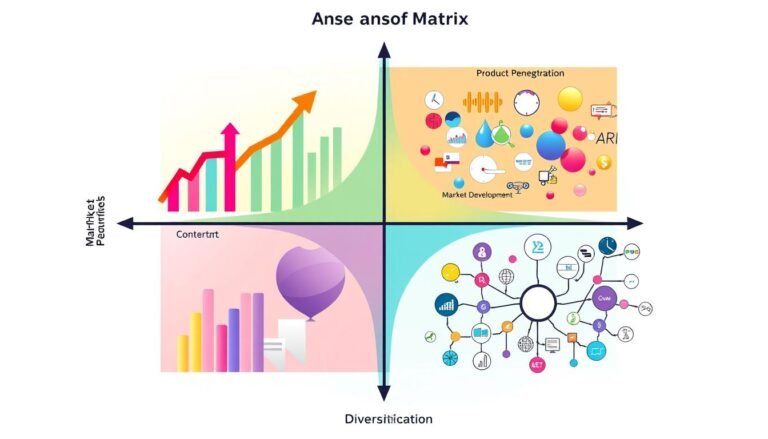Peter Drucker: Understanding Customer-Centric Marketing and Business Strategy
Imagine walking into a bookstore and the staff knows exactly what you’re looking for. They recommend a book that matches your interests perfectly. This shows Peter Drucker’s vision of a customer-centric business strategy.
Drucker is known as the father of modern management. He said the main goal of any business is to create and keep customers. His ideas stress the need to know what customers want to drive innovation and get ahead.
Drucker’s approach goes beyond just selling things. It’s about building strong connections with customers for growth and loyalty. A study on 416 Italian export firms shows how focusing on customers and building relationships helps businesses succeed.
Drucker’s ideas are still important today. With inconsistent brand messages being a top consumer complaint, businesses know they must meet customer expectations. Websites are key in building strong customer ties, as seen in the 2021 Hubspot Report.
We’ll look more into Drucker’s views on marketing and business strategy. His timeless advice helps businesses innovate, satisfy customers better, and grow in a tough market.
Introduction to Peter Drucker’s Business Philosophy
Peter Drucker’s ideas changed business for over 60 years until his death in 2005. He showed how crucial the customer is in setting business goals and strategies.
Who is Peter Drucker?
Peter Drucker is known as the father of modern management. He believed in giving power to employees and valuing their work. He also saw the future of work being based on knowledge.
He pushed for training employees and helping them grow. This showed his focus on improving the workforce and business strategies.
Drucker’s Impact on Modern Business
Drucker’s ideas have greatly influenced today’s business world. He saw businesses as part of a bigger social system. He believed in making a positive impact through corporate social responsibility (CSR).
He also talked about the power of a strong company culture led by top management. Drucker’s idea of “management by objectives” (MBO) is key to good business planning. It involves setting clear goals and tracking progress.
His methods like decentralization and MBO help companies adapt quickly, innovate, and make better decisions. For example, a survey shows that top executives spend up to 70 percent of their time on decision-making. This shows the need for strong management strategies.
| Management Principle | Key Features |
|---|---|
| Decentralization | Empowering lower-level workers with decision-making authority |
| Management By Objectives (MBO) | Joint goal-setting with measurable expected results |
| Corporate Social Responsibility (CSR) | Balancing profit-making with social good |
Overview of Customer-Centric Marketing
Drucker’s marketing ideas put the customer at the center. The Drucker Society of Austria says he believed businesses aim to create customers and focus on giving them a great experience. He thought knowing and meeting customer needs was key to success.
His ideas have shaped today’s customer-focused marketing. They highlight the importance of making customers happy as a core part of business strategy.
The Aim of Marketing According to Peter Drucker
Peter Drucker said the main goal of marketing is to know the customer so well that the product fits them perfectly. This makes selling not needed. He saw marketing as more than just promoting products. It’s a strategy that matches business offerings with what customers want and need.
Understanding the Customer
Drucker thought marketing and innovation are key to business success. Knowing what customers want is vital. This way, businesses can make products that go beyond what customers expect, making them happier.
The 2021 Moengage Report found that inconsistent messages from brands were a big problem for consumers. This shows how important it is to have a clear message that speaks to what customers want.
Making Selling Superfluous
Drucker wanted to create a world where products fit so well in people’s lives that selling isn’t needed. David Packard said marketing is too important to be left to just the marketing team. This shows how marketing should be part of all business activities.
Working together, marketing and innovation are key to success. When done right, this leads to strong customer relationships and lasting satisfaction.
| Statistic | Insight |
|---|---|
| Hubspot’s 2021 State of Marketing Report | Websites are the #2 channels used in marketing |
| 2021 Moengage Report | Inconsistent messaging is the #1 consumer frustration |
| Survey on Management Priorities | Marketing and innovation were notably missing among top priorities |
The Role of Innovation in Business Success
Peter Drucker, a famous business thinker, said that business innovation and marketing are key to any business. He pointed out that making new products or services is more important than just improving old ones. Drucker believed that systematic innovation is about actively looking for change to meet customer needs. This kind of innovation helps businesses grow and gives them a big competitive advantage.
Why Innovation Matters
Drucker thought that invention is key to growing the economy and society in a business. By making new solutions for customers, businesses can make sure their products fit the market well, making traditional selling not needed. Innovation often comes from seeing things differently or finding new ways to do things.
For example, IBM’s success with selling accounting machines to libraries was a surprise. It shows how innovation can lead to business success.
| Sources of Innovation | Examples |
|---|---|
| Unexpected Success or Failure | IBM’s accounting machines in libraries |
| Incongruity | Mismatch between expectations and outcomes |
| Process Needs | Streamlining accepted processes |
| Industry Structure Changes | Emerging new market dynamics |
| Demographic Changes | Aging population leading to new product needs |
| Perception Changes | Shifting consumer views and values |
| New Knowledge | Breakthroughs in technology driving new opportunities |
Drucker’s Views on Innovation
Drucker thought innovation should focus on the market. He said the best innovation is what meets customer needs, helping businesses stay ahead. Drucker believed entrepreneurship is about making resources create more wealth, which is all about innovation.
He also said innovations from new knowledge should be carefully added to the market. This is because there might be delays from finding something new to using it. Drucker also pointed out that making a profit should prove that business decisions are right, not the main goal. The real aim is to meet what customers need well.
Creating a Customer-Focused Business
Building a customer-focused strategy means deeply caring about giving customer value. It’s about always trying to make customers happy. Peter Drucker said that knowing and meeting customer needs is key to success.
The Importance of Customer Value
A successful business gives great customer value. For example, Green Mountain Coffee and Keurig made almost $5 billion a year by innovating and making things convenient. Edward Jones targets specific groups, helping over 7 million investors worldwide.
The Cleveland Clinic puts patients first, making them happier and improving care. This shows how focusing on customers can lead to loyalty and more money. In fact, 60 percent of loyal customers buy more from their favorite brands.
Customer Satisfaction as a Business Objective
Making customers happy is a main goal for businesses. It’s important to measure how satisfied they are. For instance, changing how long customers wait on hold shows the need for real metrics.
Most people and businesses want a great experience and are willing to pay for it. Getting a new customer is harder and more expensive than keeping an old one. But, making customers happy can save money by keeping them around.
“Attracting new customers is vital, but nurturing existing ones costs less and drives higher profitability. A satisfied customer is the best business strategy of all.” – Michael LeBoeuf
In today’s market, focusing on customer satisfaction keeps them coming back and helps businesses grow. Companies should use customer feedback to get better and innovate.
| Metric | Impact |
|---|---|
| Higher CLTV | Increased sales and profitability over time |
| Customer Retention | Equivalent to 10% cost reduction |
| Customer Acquisition Cost | 6-7x higher than retaining existing customers |
| Willingness to Pay More | 67% of consumers, 74% of business buyers |
Collaboration and Management: Key to Innovation
Peter Drucker said that strong teamwork and good management are key to making new ideas. By knowing this, companies can use creativity to bring big changes.
Strong Leadership for New Ideas
Good leaders are vital for bringing new ideas to life. Drucker pointed out that leaders should make a space where creativity can grow. They should set clear goals and push for ongoing betterment.
- Setting Clear Goals: Leaders must define clear, concise goals to guide innovation efforts and ensure alignment across the organization.
- Promoting Continuous Improvement: Encouraging constant growth and development helps cultivate an innovative mindset.
Drucker’s Management Principles
Drucker’s management ideas focus on teamwork and new ways of managing to unlock human potential. Key principles include:
| Principle | Description |
|---|---|
| Fostering Human Potential | Recognizing and developing the skills and talents of employees to promote creative problem-solving. |
| Defining Organizational Goals | Establishing clear and measurable objectives that align with the company’s vision and mission. |
| Maintaining a Growth-Oriented Approach | Cultivating a mindset focused on long-term development and adaptation to market changes. |
To get ahead in innovation, companies must blend customer insights with their operations and finances. Marketing’s changing role also boosts innovation by guiding product creation and matching customer needs with business plans. Companies like Apple and Salesforce show how combining innovation with customer focus can lead to success.
Understanding Customer-Centric Marketing and Business Strategy
Peter Drucker stressed the need to build strong customer relationships in marketing. Putting customers first helps companies grow and innovate. A study found that focusing on what customers need is key to strong relationships.
The Significance of Customer Relationships
Customer relationship management (CRM) is crucial for effective marketing. The study showed that focusing on customers leads to growth. By understanding what customers want, companies can adapt and grow globally.
Good interactions between buyers and sellers improve decision-making and build trust. This trust is the foundation of lasting relationships.
Customer Loyalty and Business Growth
Keeping customers loyal is key for repeat business and advocacy. For companies focused on customers, success goes beyond just sales. Being innovative helps these strategies work better.
Brands that invest in digital experiences and improve customer journeys get more engagement and higher sales. Most companies are now focusing on digital transformation.
| Factors | Customer-Centric Companies | Product-Centric Companies |
|---|---|---|
| Success Measurement | Customer loyalty, retention, average order value | Sales figures |
| Strategic Priority | Customer relationship management | Product innovation |
| Results of Digital Optimization | Higher engagement, increased order values | N/A |
Drucker’s ideas tell businesses to focus on customers, not just profits. This approach leads to lasting relationships and growth. It meets market needs and customer wants.
Market Segmentation and Its Importance
Market segmentation is key in marketing. It helps businesses understand and reach different customer groups well. By breaking down a big market into smaller groups, companies can make a targeted marketing strategy. This strategy meets the unique needs of customers. It makes marketing more relevant, builds customer loyalty, and helps businesses grow.
Identifying Market Segments
To find market segments, businesses look at different things that set consumer groups apart. They might look at age, gender, income, and more. They also consider values, interests, and lifestyle when segmenting psychographically. Behavioral segmentation looks at how people act, like their buying habits. Geographic segmentation groups people by where they live.
| Segmentation Type | Criteria |
|---|---|
| Demographic Segmentation | Age, Gender, Income, Education, Occupation, Family Size |
| Psychographic Segmentation | Values, Attitudes, Interests, Lifestyle, Personality Traits |
| Behavioral Segmentation | Buying Behavior, Product Usage, Response Rate |
| Geographic Segmentation | Physical Locations |
Tailoring Strategies for Different Segments
After finding market segments, businesses can make strategies for each one. They create detailed profiles to understand what each group likes and does. This way, companies can make a targeted marketing strategy that really speaks to each group. This leads to better customer engagement and loyalty.
It’s important to keep updating market segments because what people want and market trends change. Using data and research helps businesses stay on top of things. Good market segmentation makes marketing more effective and helps businesses focus on the most valuable customers.
Leveraging Data Analytics for Better Customer Insight
In today’s fast-changing business world, knowing what customers want is key. Companies that use data analytics can improve their marketing and make customers happier.
Role of Data in Marketing
Data analytics is crucial for modern marketing. It helps companies make smart choices. A Forbes survey found 86% of retail leaders think predictive analytics gives them an edge.
By looking at what customers like and do, businesses can make marketing that speaks to them. This leads to more engagement and sales. Companies like Netflix and Amazon use data to make their services better and keep customers coming back.
Using data can really help profits grow. A McKinsey study showed small retail shops that use data make 6% more profit than others. Netflix, Amazon, and Starbucks are great examples of how data analytics can make customers happier and more loyal.
Improving Customer Experience through Data
Using data analytics also makes customers happier. Companies that make decisions based on data are three times more likely to see big improvements. They can offer personalized experiences that meet what customers want, making them more loyal and increasing sales.
Companies that focus on customers do better financially. Deloitte found they’re 60% more profitable. And 48% of customers want special treatment for being loyal, showing how important it is to engage with them personally.
Adding data-driven efforts can really boost a business. McKinsey says AI can increase revenue by 15% and cut customer service costs by 20-30%. Companies that focus on the customer grow faster, showing how data analytics can drive growth and improve customer experience.
The Impact of Digital Transformation on Marketing
Digital transformation has changed how businesses market themselves. It’s not just a trend; it’s a key step to stay ahead. With digital platforms, companies can now better connect with customers.
Adapting to New Technologies
New tech has changed marketing a lot. For instance, e-commerce made up about 36% of global GDP in 2017, a 13% jump from the year before. This shows how important digital tools are for reaching more people.
By 2030, we’ll see over 100 trillion web-enabled sensors, up from just 3.5 billion in 2013. This growth means businesses must quickly adapt to stay ahead. McKinsey research suggests that by 2025, over 30% of global economic activity could be through digital platforms. This shows how big a role technology plays in marketing today.
Enhancing Customer Engagement
New tech in marketing helps reach more people and engage them better. With advanced data analytics, businesses can make their marketing more personal. This personal touch is crucial for building strong customer relationships and growth.
Marketing with a purpose is another way to connect with customers. When companies share their values and mission, they inspire both customers and employees. Working with nonprofits or causes boosts the impact of these efforts and builds trust, making customers more engaged.
| Statistic | Value | Year |
|---|---|---|
| Global e-commerce as % of global GDP | 36% | 2017 |
| Web-enabled sensors growth | 100 trillion | 2030 (estimated) |
| Digital platforms’ share of global economic activity | 30%+ | 2025 (projected) |
The shift in marketing isn’t just about new tech; it’s about making customer experiences better. By keeping up with tech and focusing on customers, businesses can succeed in the digital world.
Conclusion
Peter Drucker’s ideas on focusing on customers and innovation are key for lasting growth in business. His views show that marketing and innovation are vital for a company’s future and success.
Drucker said that good marketing means knowing what customers need and want. This approach helps companies make a big impact. It’s key for getting better results, keeping customers happy, and building loyalty.
Studies by Frederick E. Webster Jr. also highlight the importance of balancing short-term gains with long-term growth through constant innovation.
Businesses need to grow by using Drucker’s advice. This means innovating not just in products but also in how things are done and in the company’s structure. To stay ahead, companies must understand what customers like and what they want.
Creating a company culture that values customers and uses different marketing ways to talk to them is crucial. Following Drucker’s advice on focusing on customers and innovating is essential for lasting success in business.
Source Links
- Customer-centric strategy driving innovativeness and business growth in international markets
- Marketing IS Business: The Wisdom of Peter Drucker – Marketing Insider Group
- Peter Drucker’s Management Theory Explained
- What Is Peter Drucker’s Management Theory?
- Peter Drucker On Marketing
- Drucker on Product Management
- Seven Sources of Innovation by Peter Drucker – MBA Knowledge Base
- Marketing Is Innovation
- Boost Organizational Focus with Peter Drucker’s Method | Salesforce Trailhead
- 9 Proven Ways to Create a Customer Driven Marketing Strategy
- If You Really Aspire to "Customer-Centric," Center on These Four Principles
- Can We Get Beyond Customer Centricity?
- What B2B Marketing & Product Teams Can Learn From Peter Drucker
- Customer-Centric Approach in Creating Digital Experiences
- Exploring the Purpose of Business with Peter Drucker
- What Is Market Segmentation? And its Importance for Your Business.
- Why Customer Centricity Is (Still) the Secret to Business Success
- Chapter 3 – Marketing Basics
- The Power of Data-Driven Decision Making: Leveraging Analytics for Business Success – iWeb Ecommerce Partner Agency
- Transforming the Customer Experience: Leveraging Technology and Data to Drive Customer-Centricity
- The Rise of Purpose-Driven Marketing: Aligning Values with Business Goals
- Is marketing the missing ingredient from the boardroom?
- Marketing Is Business: The Wisdom Of Peter Drucker
- Joshua D. on LinkedIn: Peter Drucker on "Innovation and Marketing" explores the vital role of…






